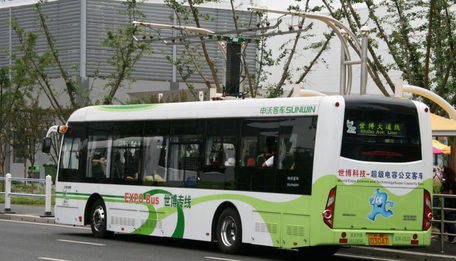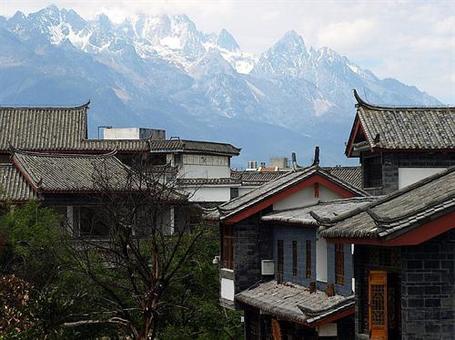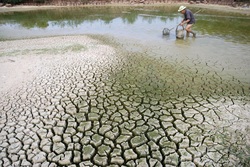 Expo 2010 Electronic Bus With the development of science and technology, China is experimenting with a new anatomy of electric, which also called capavehicle or electric bus, which runs after connected aerial curve by application ability stored in ample onboard electric double-layer capacitors, which are bound recharged whenever the car stops at any bus stop (under alleged electric umbrellas), and absolutely answerable in the terminus.This new innovation greatly improves the efficiency of capacitor use. According to the preliminary test, the result shows that the super capacitor solves the problem of capacitor heating and energy over-consuming. The capabuses normally need to stop regularly every 3 miles (4.8 km) or less, allowing quick recharging at charging stations at bus stops. A collector on the top of the bus rises a few feet and touches an overhead charging line at the stop; within a couple of minutes the ultracapacitor banks stored under the bus seats are fully charged. The buses can also capture energy from braking, and the company says that recharging stations can be equipped with solar panels.
http://www.slideshare.net/ResearchIndia/super-capacitor-buses-in-shanghai-5156990
Capabus in Shanghai is an excellent illustration of the cornerstones for fair trade and eco-tourism.
- Fair Working Conditions: The capabus help the visitors in expo site to quickly get to the destination, and the buses are accessible for people who are working within Expo site without charge. There is no private cars or vehicles in the site, so this become the most important transportations for those who visit the World Expo.
- Fair Prices: Regardless of where a visitor plans to any pavilion, the capabus are free to all the visitors.
- Integration Into the Local Economy and Regional Development: Of course the capabus makes more convenient for visitor to get to the pavilions, restaurants and souvenir stores in the site. This also eliminates cars exhaust emissions.
- Fair Trade Partnerships Between All Actors in Tourism: Since the use of the capabuses are free to all the visitors, this helps the transportation be in order, and decrease the traffic jams and accidents. It also encourages the tourists to spend their money in the World Expo Site.
- Sustainable Resource Use and Environmental Justice: The capabuses utilize super capacitor, which eliminates air pollution.That's why many people said the air quality and weather in Shanghai were better than before during the world expo. The capabus matches the theme of world expo "Better city, better life". It is a new form of electric bus powered via energy stored in large onboard super-capacitors instead of being lost via wheel brakers or rheostats.
 Lijiang Tianlu, a high-end tourism resort project in Lijiang, Yunan
Travel and tourism are among the world's fastest growing industries and are the major source of foreign exchange earnings for many developing countries. China is one of the developing countries. But environmental deterioration is affected the country development. Bunch of research talked about the Low-Carbon Management of Tourism Service in Holiday Resorts with Chinese Rural Characteristics, especially after the first low-carbon resort built in western China.
Major components of the Lijiang Tianlu project are an international convention center and a five-star hotel. The project features a total floor area of 250,000 square meters, of which the international convention center will occupy 50,000 square meters. As the first low carbon tourism resort project in western China, the focus will be on energy conservation, environmental protection and intelligent use of resources; and the harmony between buildings and the environment will be the highlight of the project.
As we all know, ecotourism is a growing niche market within the larger travel industry, with the potential of being an important sustainable development tool. Tianlu designed some ecological principles and let more guests know about the ecotourism and the resort does give the guests more special experience and good satisfaction. The ecotourism principles are fulfilled, such as conserving natural areas, Tianlu doesn't make water pollution and air pollution. There are many ecotourism guidelines to show some environmental protection in the lobby and elevators. The staff also try to educate visitors about sustainability and talk about what's the reason make the climate change. After owning money, the resort also benefit the local people as a charity.
The project is expected help Lijiang become one of the best meeting and conference destinations in China and Asia with the highest degree of internationalization. On the other hand, Tianlu resort shows Chinese's determination to cover the environmental issue and be careful of
 The climate change in China Tourism is one of the major victims of climate change, especially long-distance travel, which have large carbon footprint. It’s not only for climate change impacts tourism, but also tourism affects climate change. Pollution is the main reason of climate change and indirectly affects the tourism industry. Because of many pollution, China faced the big issue about climate change. Especially the agriculture in China is affected by climate change, mudslides, soil erosion, sandstorm make some areas being barren. As a first-year graduate student, I try to use the low-carbon economy theory to decrease the low-carbon footprint. How to develop sustainable tourism is one of trends in the tourism field.
|



 RSS Feed
RSS Feed